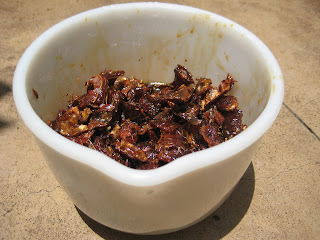 |
| A ripe pod of tamarind |
 |
| Neatly packed, ready to go! |
 |
| A tree of many seasons |
 |
| Tamarind tree in bloom |
The second reason I am flooded with tamarind is because a couple of weeks ago, another friend called to say that she had harvested some tamarind from her farm and could I find out if anyone might want some? Since then, I have become a sort of sales agent, commissioning and selling packets of farm fresh, organic, sun dried tamarind. This has been a pleasant exercise, helping me renew contact with several acquaintances and friends. Some people have reserved many kilos and are yet to come and collect it and as my friend only visits the city once in a while, the bags repose in my house, awaiting their new owners. I am pleased to mention that I successfully sold all the tamarind but at the end of it we realized she had barely broken even! Next year, the prices will be fixed more wisely (but we have generated a lot of goodwill this season)!
Now, to the pickle. I'm sure better recipes exist and I will need to optimize this one. I have modified it a little, for as many old family recipes go, the original recipe was a mere outline. After hearing horrific tales of my husband's grandmother, who purposely left out one key ingredient each time someone asked her for a recipe, I requested members of the current generation to verify this recipe before sending it. It turns out that no one makes tamarind pickle any more. So I cannot guarantee that this method produces a 'genuine' Bangali pickle, but it tastes fine and is as good a way as any, to eat tamarind without blowing out your taste buds. Here goes:
250 g tamarind, fresh off the tree (with outer pod and seeds removed - you can use store bought stuff too!)
250 g jaggery dissolved in a cup of water, boiled and strained
1 Tablespoon panch phoron (a mix of spices, see footnote) (I roasted and lightly pounded this)
2-4 whole red chillies (or to taste), powdered (I de-seeded and roasted them first)
2 Tablespoons mustard oil (see footnote)
50 g salt (I mixed regular and rock salt to make it less salty, I think 30 g regular salt should probably do)
 |
| Use as many (or as few) chillies as you like |
 |
| Jaggery - a key ingredient |
 |
| A gooey mess! |
The recipe called for raw turmeric powder and mustard oil, a great Bengali favourite that is dabbed on this and that, 'just to be sure'. While I omitted the turmeric, I fell for the mustard oil, thinking that it might have been included as a preservative or to provide a distinctive Bengali flavour. As soon as I tasted the raw pickle, I felt the oil was a mistake; it just doesn't go with the rest of the flavours. I console myself with the thought that its sharpness will be beaten down by the sun and the other ingredients over time, and this seems to be the case (perhaps it will also repel the ants). The one omission in the original recipe was - salt! Needless to say, this is essential, for various reasons. I put in a little extra for good measure but one can tone it down.
Coming to panch phoron - the Bengali five spice mix - this is sold in markets commonly in the east and is now available in Bengali markets in various parts of the country. Last year, over a family dinner, we were discussing where one could buy the best panch phoron. Each woman had her own special source and when it was my turn, there was just silence. On prodding, I revealed that I always made my own, which was the best possible - and got pained looks from all and sundry! But, it's true! No one makes panch phoron at home now though it is trivial to do - you end up with good quality spices mixed in the ratio you desire and not some arbitrary packet of condiments. Opinions about the constituents of panch phoron vary. The basic ingredients are fenugreek (methi) seeds, cumin (jeera) seeds, nigella (kalonji or kala jeera) seeds, fennel (saunf) seeds and either black mustard (sarson) seeds or radhuni (no clear English translation for this, the closest seems to be wild celery) seeds, in equal amounts. I vary the ratio a little, to suit my taste.
 |
| My panch phoron |
 |
| Pickle, innocuously sunning 'midst the lilies |
1 comment:
You can easily Buy Tamarind Pickle online in Foodzu
Post a Comment